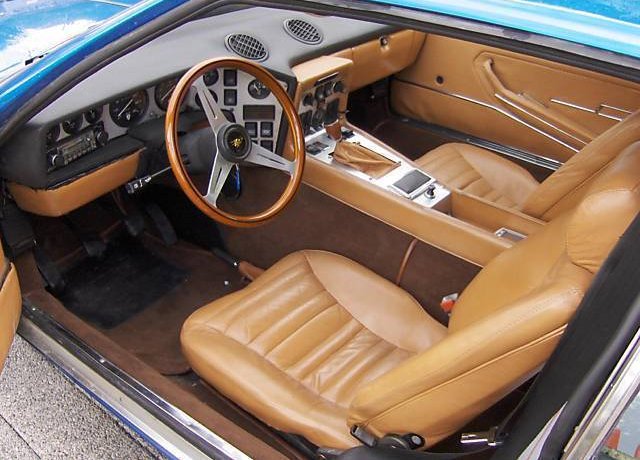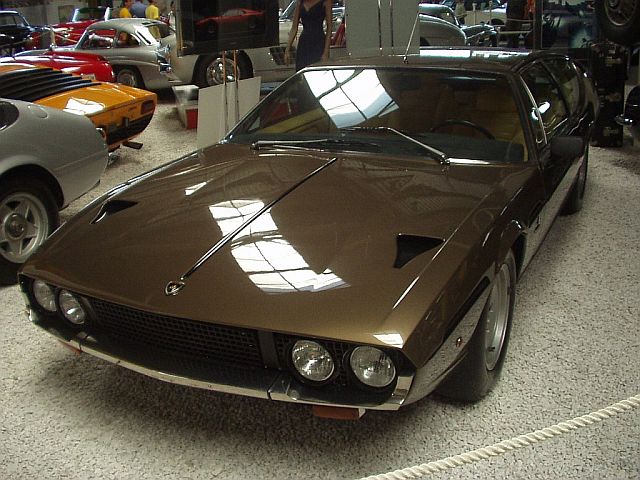Description
The Lamborghini Espada 400 GT Series III, introduced in 1972, represented the final and most refined evolution of Lamborghini’s remarkable four-seat grand tourer. It was the culmination of nearly a decade of development, bringing together the company’s unmatched V12 performance with the luxury and sophistication expected of a world-class touring car. With its improved comfort, updated styling, and even more powerful engine, the Series III became the definitive Espada—an elegant yet ferociously capable grand tourer that perfectly embodied Ferruccio Lamborghini’s original vision of effortless high-speed travel for four.
By the early 1970s, the Espada had already established itself as one of the most striking and distinctive GTs on the road. Its sharp, geometric design by Marcello Gandini of Bertone was unlike anything else in production: low, wide, and futuristic, with its long bonnet, sweeping roofline, and large glass areas giving it a commanding yet refined presence. For the Series III, Gandini’s design was subtly modernized to meet changing safety regulations and aesthetic trends while preserving the car’s unmistakable identity. The front received a new bumper design with integrated lights and a slightly revised grille, while the tail gained cleaner, rectangular taillamps and a redesigned rear valance. These updates lent the Series III a more contemporary and muscular look, without compromising its sculptural elegance.
Under the bonnet, the Espada Series III retained Lamborghini’s magnificent 3,929 cc all-aluminium V12 engine, designed by Giotto Bizzarrini and continuously refined by the company’s engineers. In this final version, the engine delivered 350 horsepower at 7,500 rpm and around 392 Nm of torque. Six twin-choke Weber carburetors and four overhead camshafts gave it exceptional responsiveness and smoothness, while the five-speed manual gearbox provided precise, positive shifts. In 1974, Lamborghini also introduced a three-speed Chrysler TorqueFlite automatic transmission option for the Series III—marking the first time an automatic was available in a V12 Lamborghini. This broadened the car’s appeal, especially among grand touring buyers who valued refinement and ease of use alongside performance.
Performance remained formidable. The Espada could accelerate from 0 to 100 km/h (62 mph) in just over six seconds and reach a top speed of around 255 km/h (158 mph), making it one of the fastest four-seat cars of its day. Yet despite its speed, the car was remarkably smooth and composed. The long wheelbase, fully independent suspension, and wide track ensured outstanding stability at high speed, while ventilated disc brakes on all four wheels provided powerful, progressive stopping. The rack-and-pinion steering, refined for the Series III, offered lighter operation and improved precision, making the car easier to handle in both city traffic and on open roads.
Inside, the Series III Espada offered one of the most luxurious interiors ever fitted to a Lamborghini of its era. The dashboard was completely redesigned for greater functionality and comfort, featuring a horizontal layout with deep-set instruments and refined materials. Rich leather upholstery covered nearly every surface, from the deep, contoured seats to the door panels and center console. The cabin was quieter and more insulated than before, with improved air conditioning, soundproofing, and switchgear. Options included tinted glass, electric windows, and a premium sound system, while the rear seats provided genuine comfort for adult passengers—something few high-performance cars could claim. The blend of Italian style and practicality made the Espada a true long-distance touring machine, equally at home on Alpine passes as it was cruising across the European autostrada.
Driving the Espada 400 GT Series III was an experience that blended grand touring serenity with the thrill of raw V12 power. The engine delivered a smooth wave of torque, surging forward effortlessly in any gear. The gearbox was light and accurate, while the car’s balance and suspension tuning gave it an agility that belied its size. The steering communicated with clarity, and the wide stance allowed for secure cornering at speed. The Espada was not a sports car in the traditional sense, but a high-speed express designed to cover vast distances with ease and authority.
Production of the Series III continued until 1978, making it the longest-lived version of the Espada and the final iteration of Lamborghini’s front-engined V12 grand tourers. Approximately 456 examples were built, contributing to a total Espada production of just over 1,200 cars across all series—making it the most successful Lamborghini model of its early era.
The Espada Series III marked the culmination of Ferruccio Lamborghini’s dream to create the ultimate grand touring car: one that could carry four people in comfort while delivering the sound, speed, and style that defined the brand. Though often overshadowed by the mid-engined Miura and Countach, the Espada remains one of Lamborghini’s greatest achievements—a car of vision and substance that combined avant-garde design with practicality and technical excellence.
Today, the Lamborghini Espada 400 GT Series III stands as a masterpiece of 1970s automotive design and engineering. Its blend of performance, craftsmanship, and daring aesthetics has earned it a lasting place among the most important grand tourers ever built. It was the final word in Lamborghini’s front-engined V12 heritage—graceful, powerful, and unmistakably bold—a grand touring icon that still commands admiration for its presence, innovation, and unrepeatable character.


